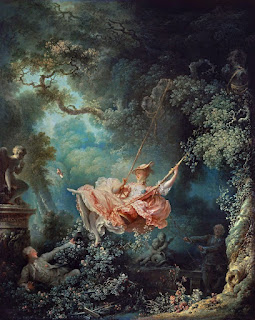Morality in the Art of the Classical Era
The Swing
Jean-Honore Fragonard
1767, oil on canvas, painted in France
Diana Leaving the Bath
Francois Boucher
France, 1742, oil on canvas
Jules-David Cromot, Baron du Bourg, marble
Jean-Baptiste Lemoyne II, French, 1704 - 1778
As I've stated before, I'm pretty shallow person. I enjoy toilet humor, dad humor, and movies with copious explosions, gun fights, and one line zingers, best delivered in an Austrian baritone or an American drawl. And being a child of the 80s, though realistically the 80s didn't reach the village till the end of the 90s, I'm fairly desensitized.
But here in these pieces, if you look as closely as the research on them I did looks, there is evident a shift in what is demanded in art, though that shift is at first restricted to the cabinets of the aristocracy. Cabinets being the inner chambers of their affluent residences, not the cupboard in which you and I keep our dishes. This is where they did their entertaining, their looser socializing, likely where they continued imbibing after they had too much for the polite company that left at a decent hour.
The aristocrats were rich nobility, many with nothing better to do than eat, drink, pontificate, and fornicate. The last activity, though they all knew it happened, could still cause great shame under the wrong circumstances, but that doesn't mean they didn't want art that hinted at it.
Take The Swing, for example. Surely, it's just a nice young woman on a swing right? That's what I thought with my shallow cursory glance. But if you examine the darker toned periphery, from which our focus is distracted by the bright colors of the female centerpiece and her garb, further directed so by the lines of the ropes of her swing, the picture has much...darker...salacious...cuckoldery. Notice the older gentleman to the right, pulling her into her swing. Innocent momentum? Maybe, or maybe they represent reigns, like on a horse, with which he, the husband apparent, attempts to control his young nubile bride. At the old man's feet a yapping white dog, a sign of pure loyalty, sounding the alarm on her lover down to the left, hidden in the rosebush, looking up her skirt, which she happens to have opened by kicking off her shoe, which is flying at Cupid, shushing the world while drawing one of is arrows from his quiver. Dirty, dirty. Quite the shift from the puritanic icons that were in demand when only royalty, closely intertwined with the other demand, the educated Clergy, were the source of income for artists.
Diana Leaving the Bath. Or...or resting after her bath, depending on your source. Boucher was known for such paintings. Diana is a Roman god of hunters and travelers, she's accompanied here by a nymph...licentious ain't it? They're both in a state of undress, but don't let that fool you. Again, in the darker periphery, are the accoutrements of a hunter; a bow, arrow, and collected game. But prominently displayed are her mammary glands and areolas, a prominent pink, for which Boucher was known for using. Strength and sexiness on bright display. Quite a departure from the demurity expected from women at the time. Such paintings as these two would be later heavily criticized as the pendulum went back the other way.
Jules-David Cromot, Baron du Bourg, the marble bust. Observe the coy smirk, lips nearly parted. The flowing garb barely covering what has to be a lean yet well muscled chest. He's manly as hell, without being a parody, like Jeff in Rules of Engagement.
It seems to me that this was a period, not unlike the 60s, or any damn time period compared to the previous, of a particular awakening. Maybe not to acts, as we've been built like this for a ling time, but to levels of acceptance. As certain powers wane others grow, and they pendulate. The paintings above, as demanded as they were at their time of production, will later be heavily criticized. One hopes that though we evolve we always have some rules written in stone, but evolution is ongoing.
Dr. Steven Zucker and Dr. Beth Harris, "A beginner’s guide to Rococo art," in Smarthistory, January 7, 2016, accessed July 6, 2023, https://smarthistory.org/a-beginners-guide-to-rococo-art/.
Dr. Ashley Bruckbauer, "Jean-Honoré Fragonard, The Swing," in Smarthistory, February 26, 2021, accessed July 6, 2023, https://smarthistory.org/jean-honore-fragonard-the-swing/.
“Diana Resting After Her Bath.” Diana Resting after Her Bath by Boucher, Franois, www.wga.hu/html_m/b/boucher/1/diana_re.html. Accessed 6 July 2023.
Macdonald, Deanna. “Diana Leaving the Bath.” Great Works of Western Art - Diana Leaving the Bath, www.worldsbestpaintings.net/artistsandpaintings/painting/32/. Accessed 6 July 2023.
18th-Century France — The Rococo and Watteau. 18th-century France - the Rococo and Watteau. (n.d.). https://www.nga.gov/features/slideshows/18th-century-france-the-rococo-and-watteau.html#slide_11





Temple when I was reading your blog it brought out a simple thinking of the classical era of just ordinary people. The first painting relaxing to me. A woman in a swing just swinging away on a nice beautiful day. The second painting of a woman getting out of bath, just sitting there talking to her friend and not really caring about covering up. It shows a confident woman. I like how you bring out woman natural beauty from the classical era.
ReplyDelete